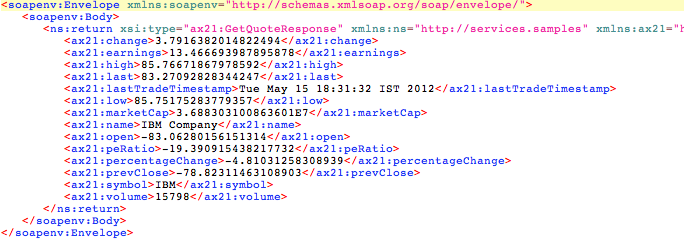This section explains, through an example scenario, how the Scatter-Gather EIP can be implemented using WSO2 ESB. The following topics are covered:
| Table of Contents |
|---|
...
- Download and install WSO2 ESB from http://wso2.com/products/enterprise-service-bus. For a list of prerequisites and step-by-step installation instructions, refer to Installation Guide in the WSO2 ESB documentation.
- Start three sample Axis2 server instances on ports 9000, 9001, and 9002. For instructions, refer to the section Setting Upp the ESB Samples - Starting the Axis2 server in the WSO2 ESB documentation.
...
| Code Block | ||||
|---|---|---|---|---|
| ||||
<?xml version="1.0" encoding="UTF-8"?>
<definitions xmlns="http://ws.apache.org/ns/synapse">
<proxy xmlns="http://ws.apache.org/ns/synapse" name="ScatterGatherProxy" transports="https http" startOnLoad="true" trace="disable">
<description/>
<target>
<inSequence>
<clone>
<target>
<endpoint name="vendorA">
<address uri="http://localhost:9000/services/SimpleStockQuoteService/"/>
</endpoint>
</target>
<target>
<endpoint name="vendorB">
<address uri="http://localhost:9001/services/SimpleStockQuoteService/"/>
</endpoint>
</target>
<target>
<endpoint name="vendorC">
<address uri="http://localhost:9002/services/SimpleStockQuoteService/"/>
</endpoint>
</target>
</clone>
</inSequence>
<outSequence>
<log level="full"/>
<aggregate>
<completeCondition>
<messageCount min="3"/>
</completeCondition>
<onComplete xmlns:m1="http://services.samples/xsd" xmlns:m0="http://services.samples" expression="//m0:return">
<enrich>
<source xmlns:m1="http://services.samples/xsd" clone="true" xpath="//m0:return[not(preceding-sibling::m0:return/m1:last <= m1:last) and not(following-sibling::m0:return/m1:last < m1:last)]"/>
<target type="body"/>
</enrich>
<send/>
</onComplete>
</aggregate>
</outSequence>
</target>
</proxy>
</definitions> |
Simulating the sample scenario
Use a SOAP client like SoapUI to send the following request to the
ScatterGatherProxyservice.Code Block language html/xml <soapenv:Envelope xmlns:soapenv="http://schemas.xmlsoap.org/soap/envelope/" xmlns:ser="http://services.samples"> <soapenv:Header/> <soapenv:Body> <ser:getSimpleQuote> <ser:symbol>foo</ser:symbol> </ser:getSimpleQuote> </soapenv:Body> </soapenv:Envelope>- Because the log mediator is enabled inside the outSequence, there will be three responses from the three vendors. The logs will be similar to the following:
- In SoapUI, you will get the response from the vendor providing the best quote as follows:
- Compare the logged response messages with the response received by the client to see that the
ScatterGatherProxyservice returns the best quote to the client.
How the implementation works
...

